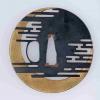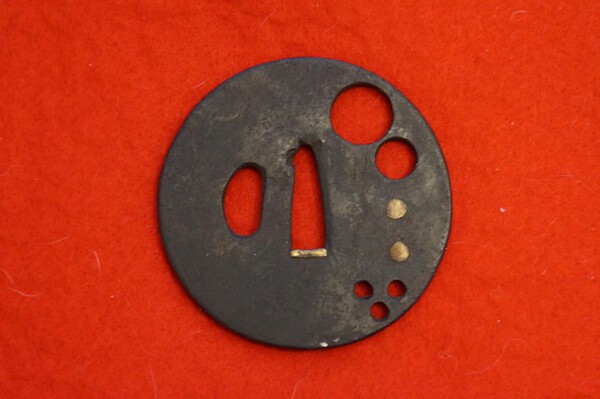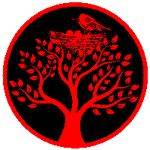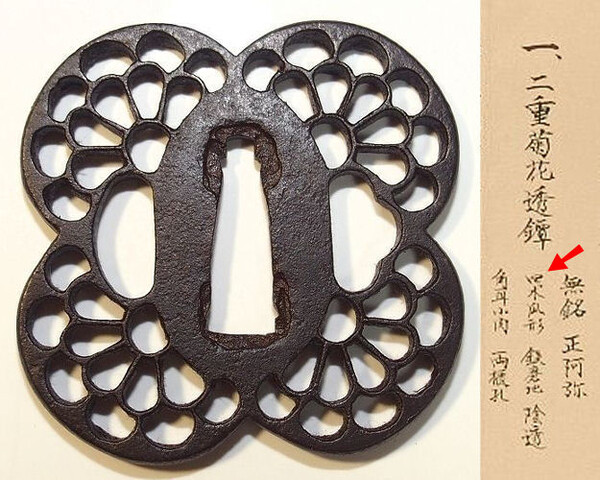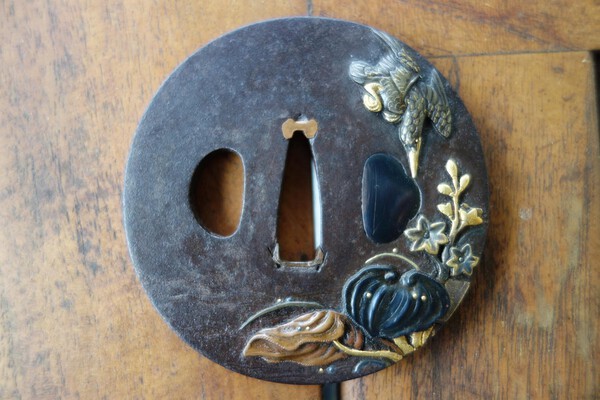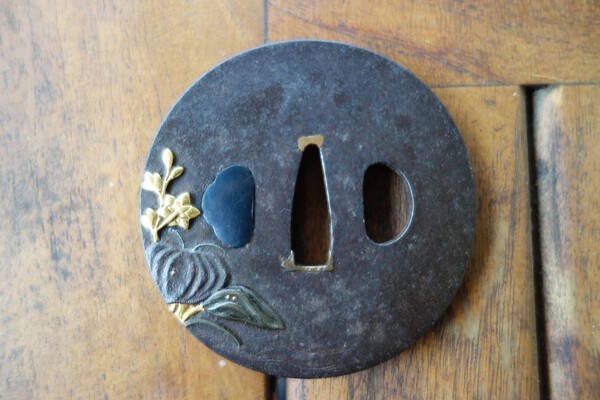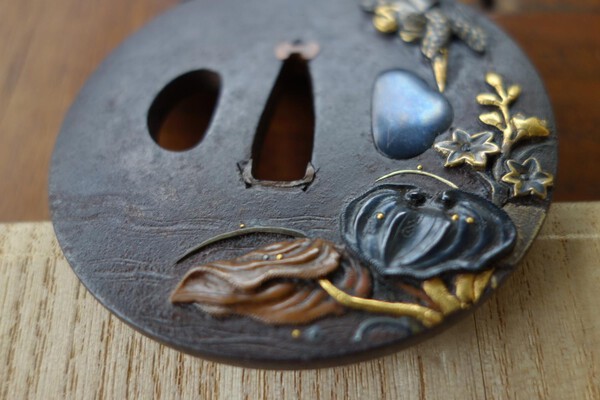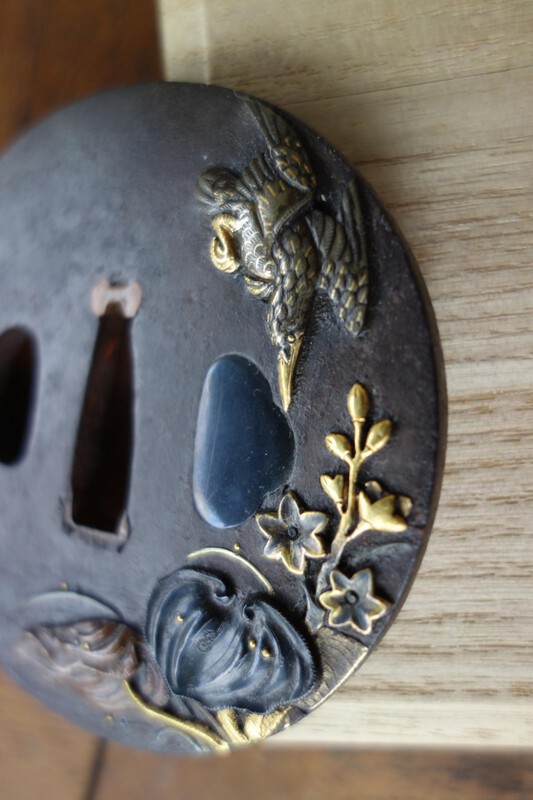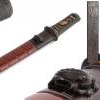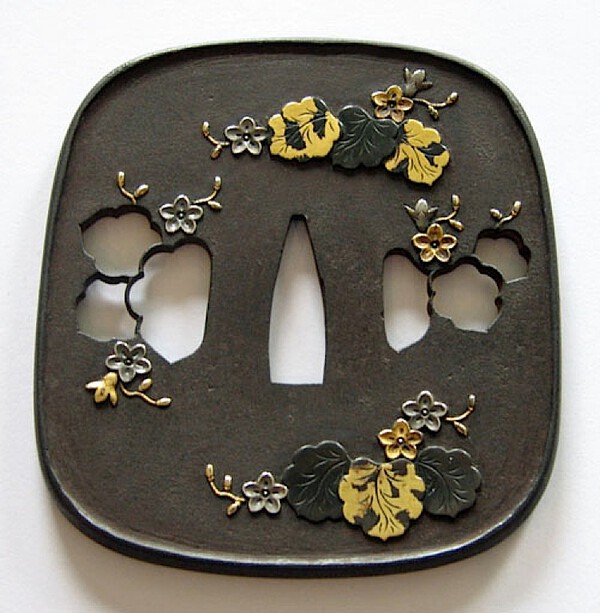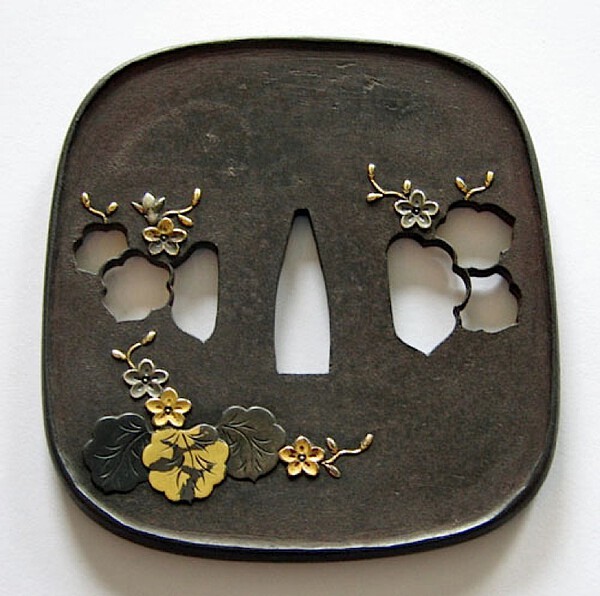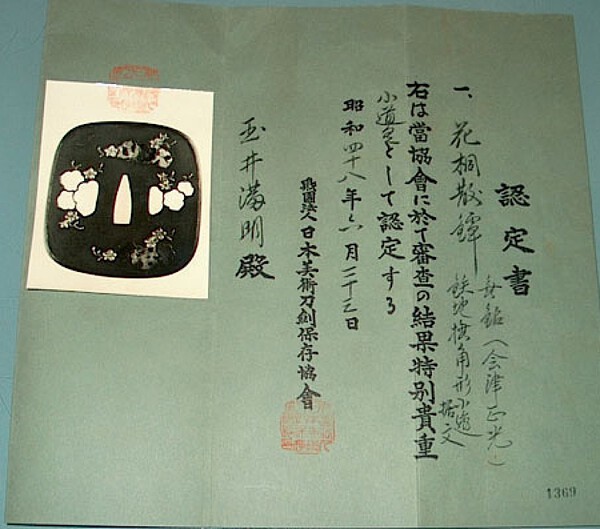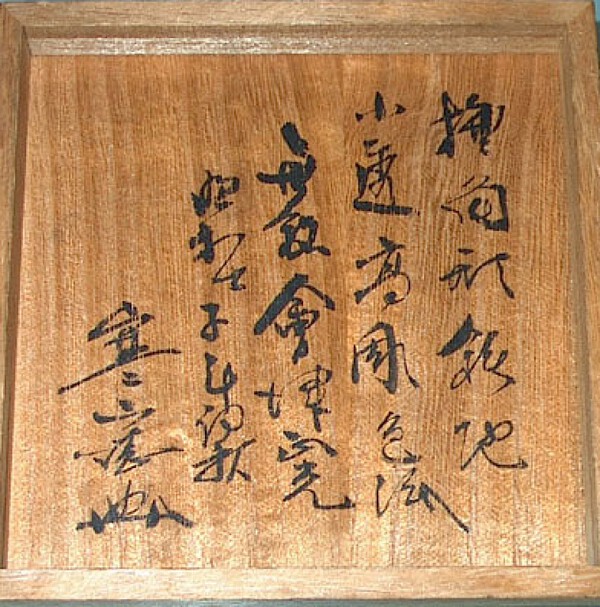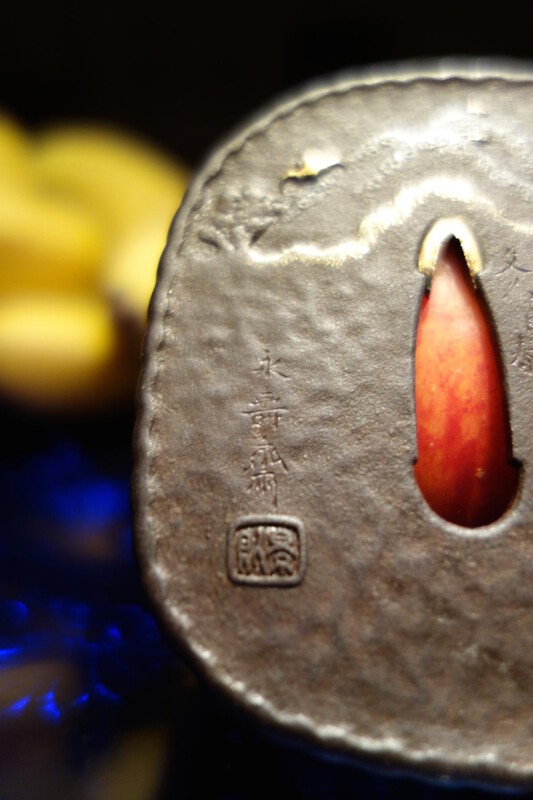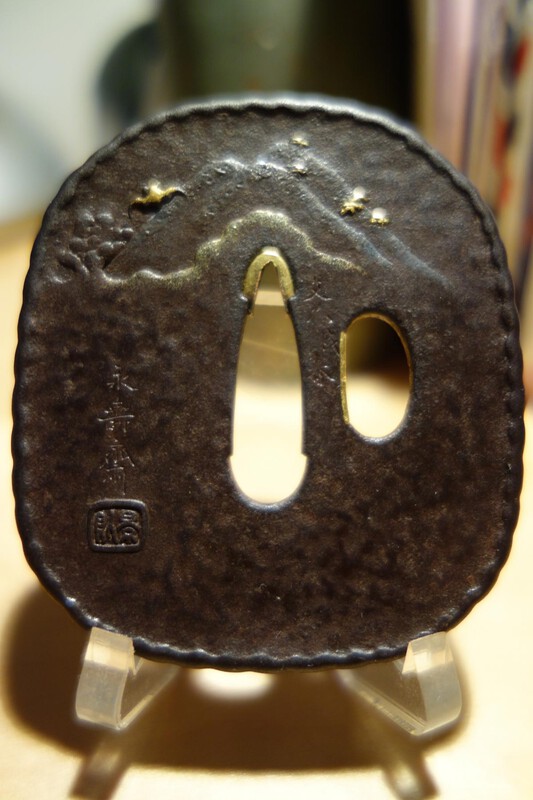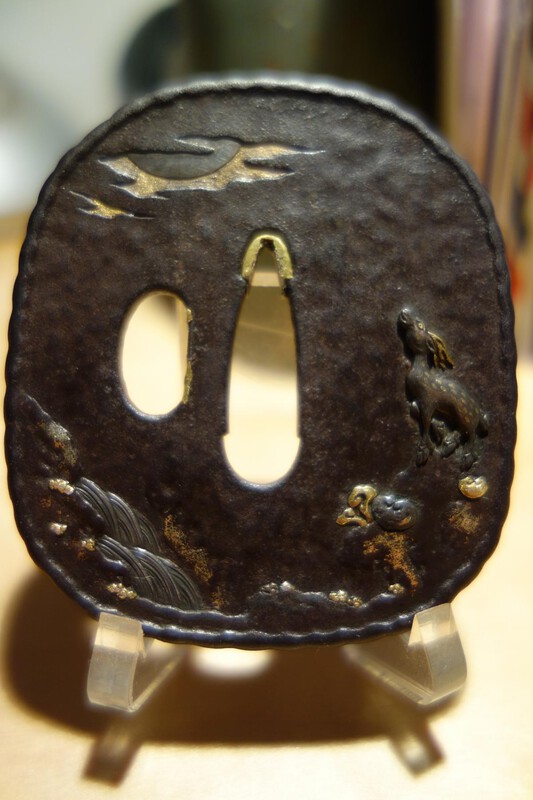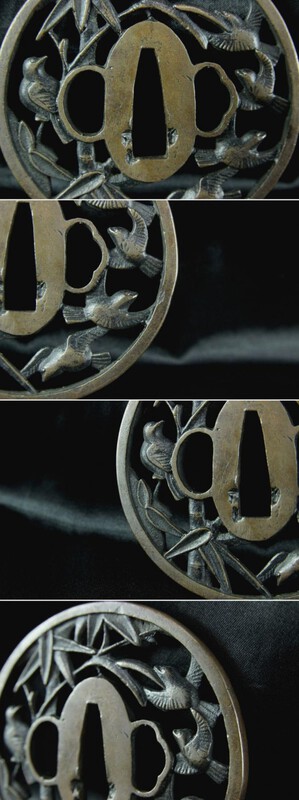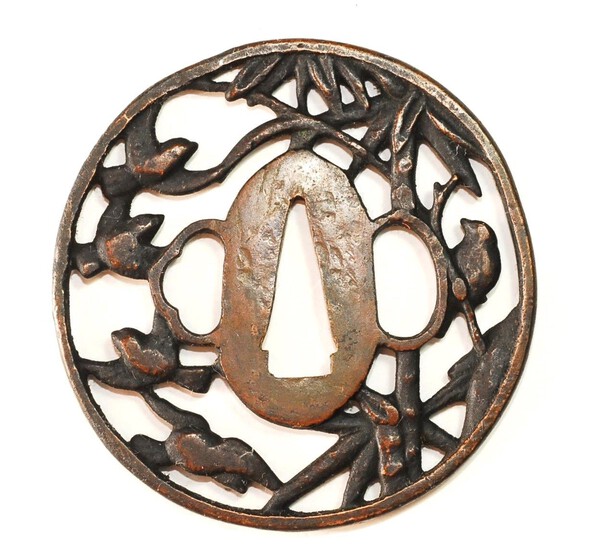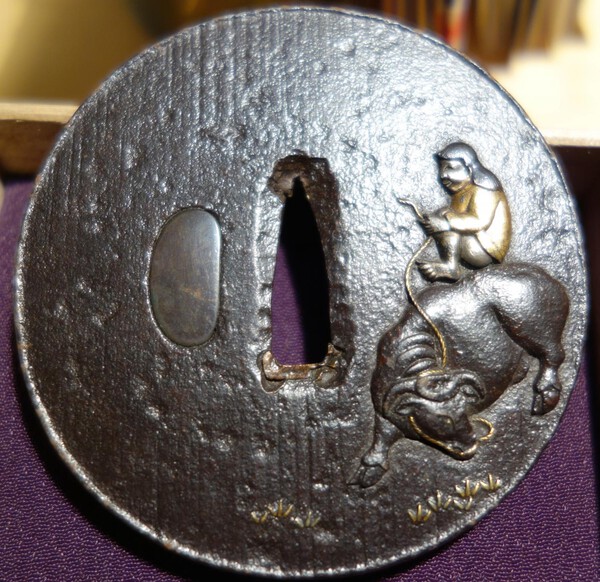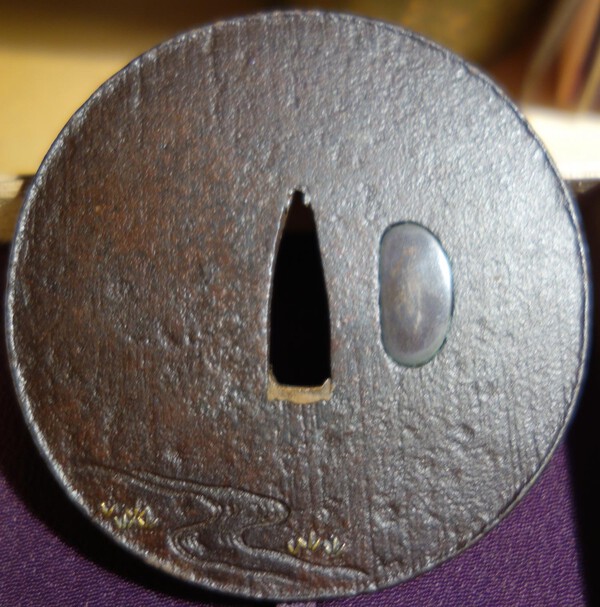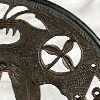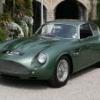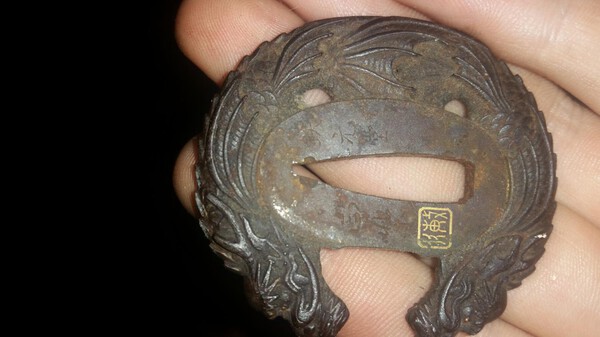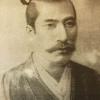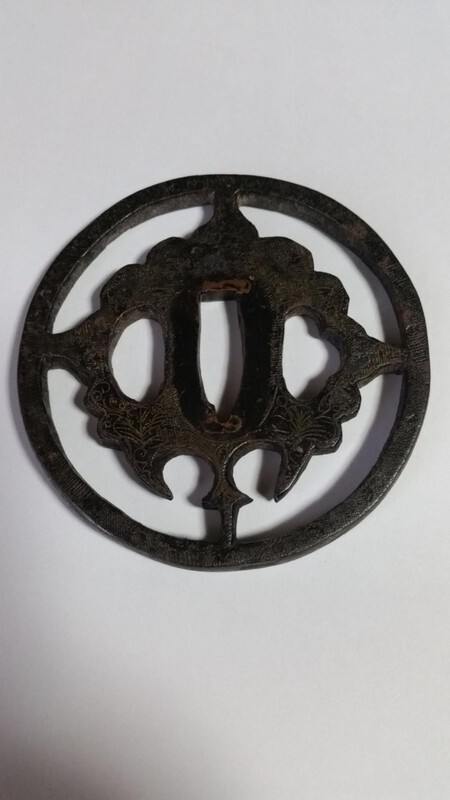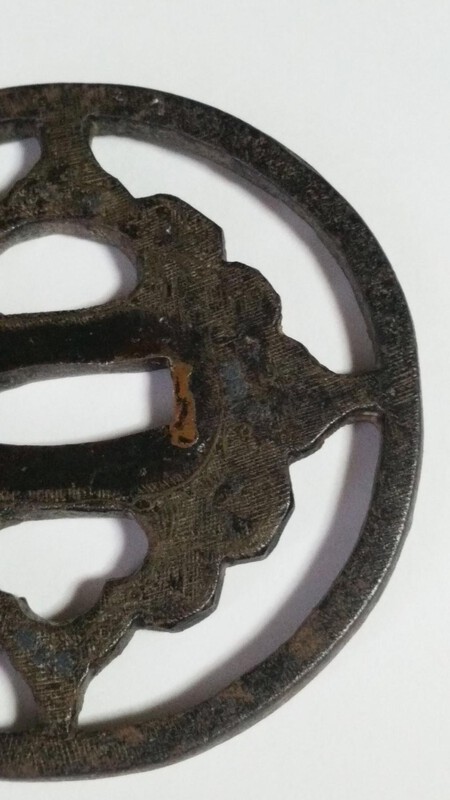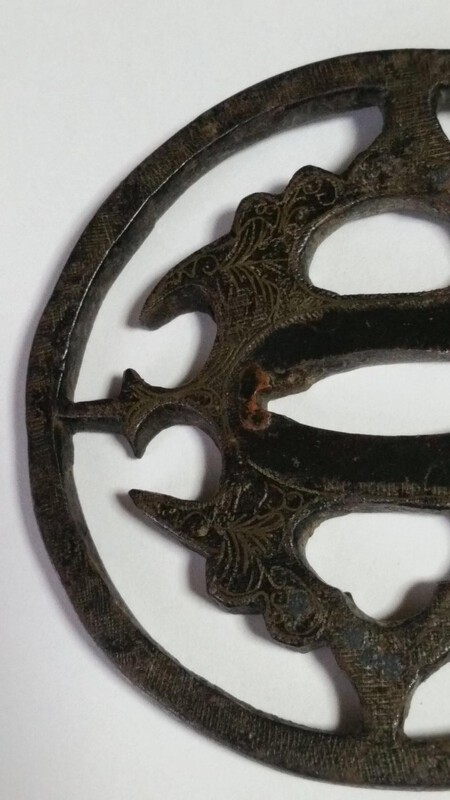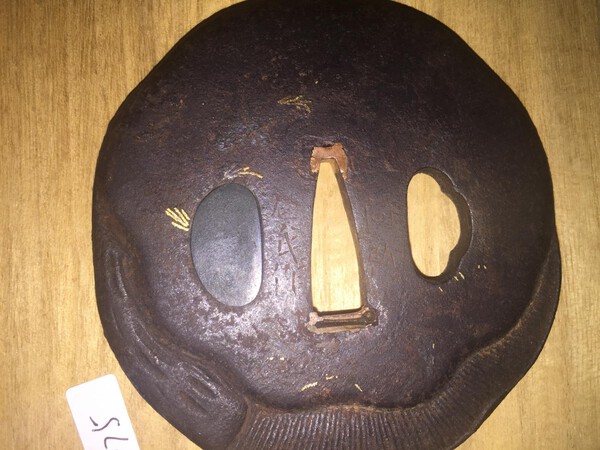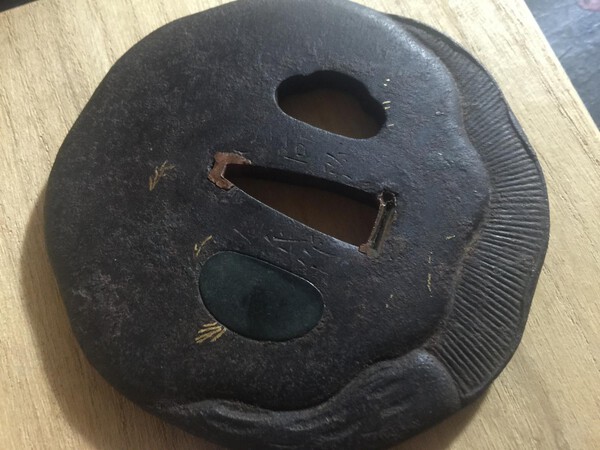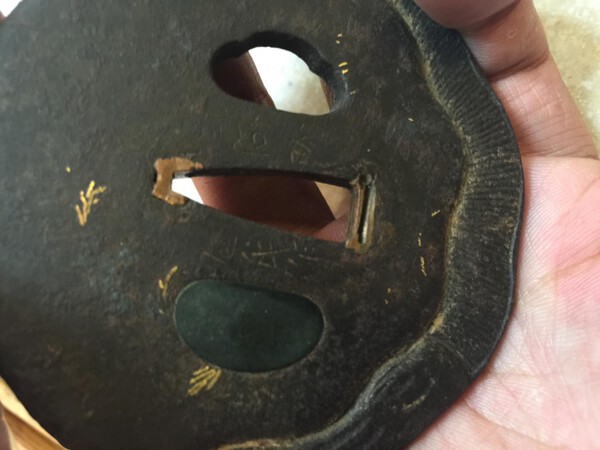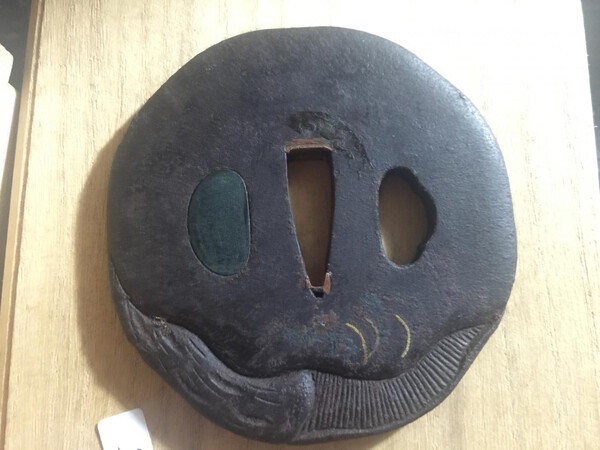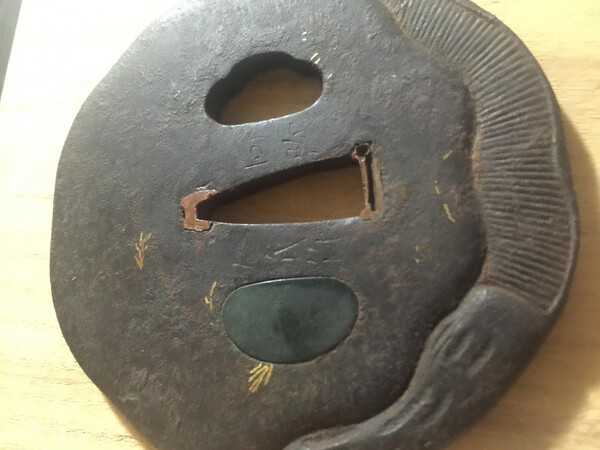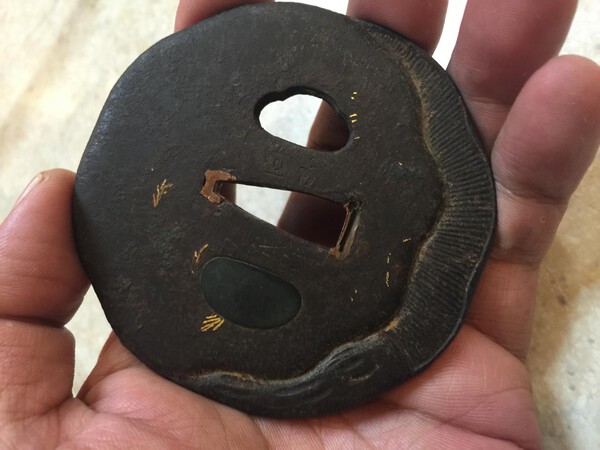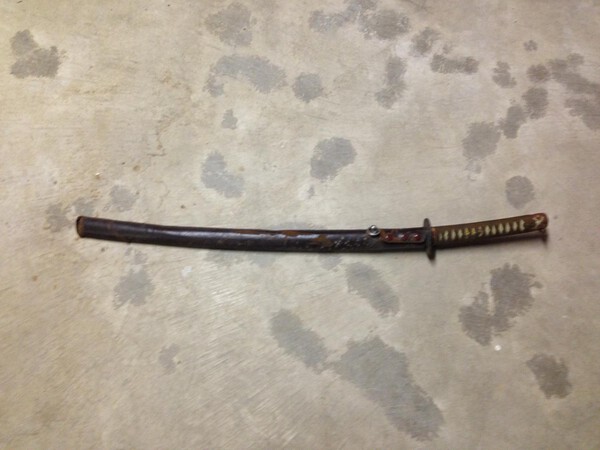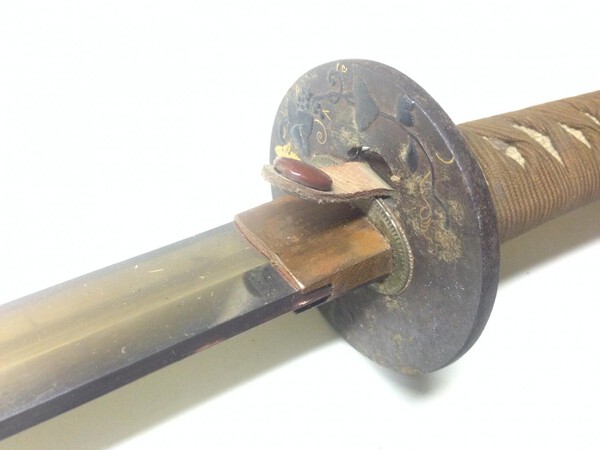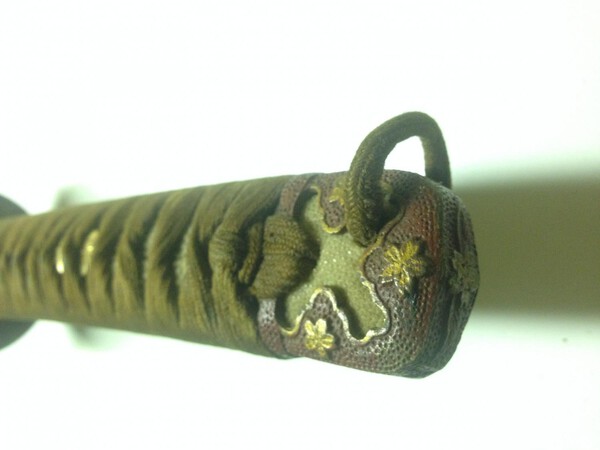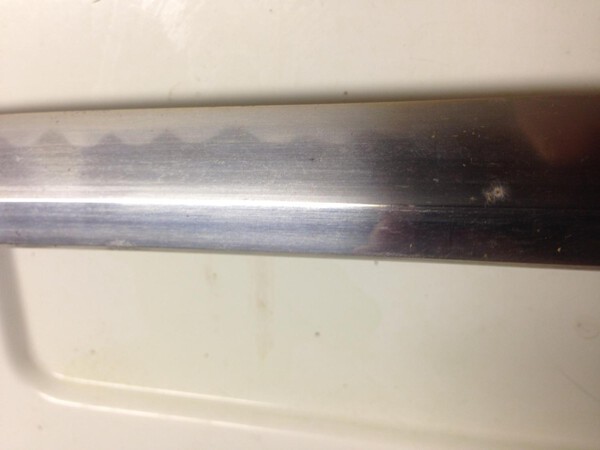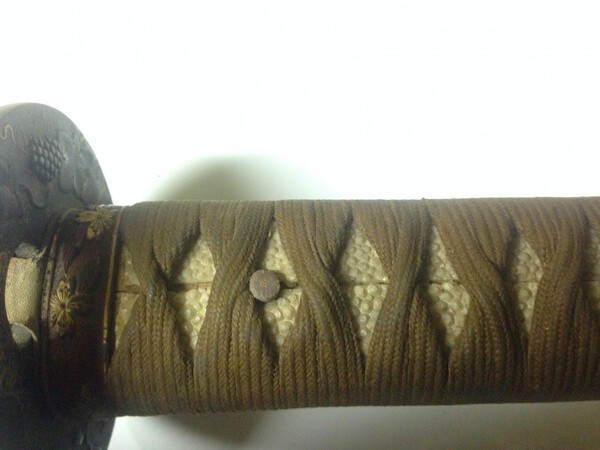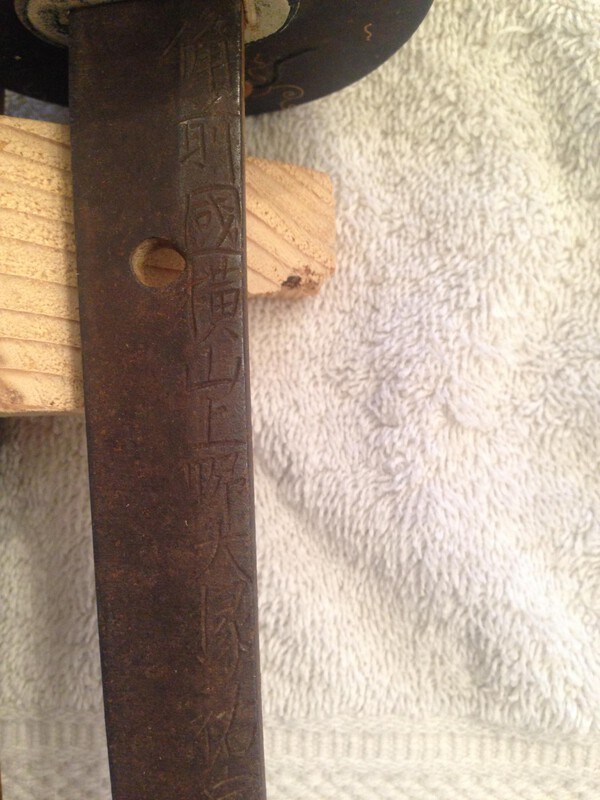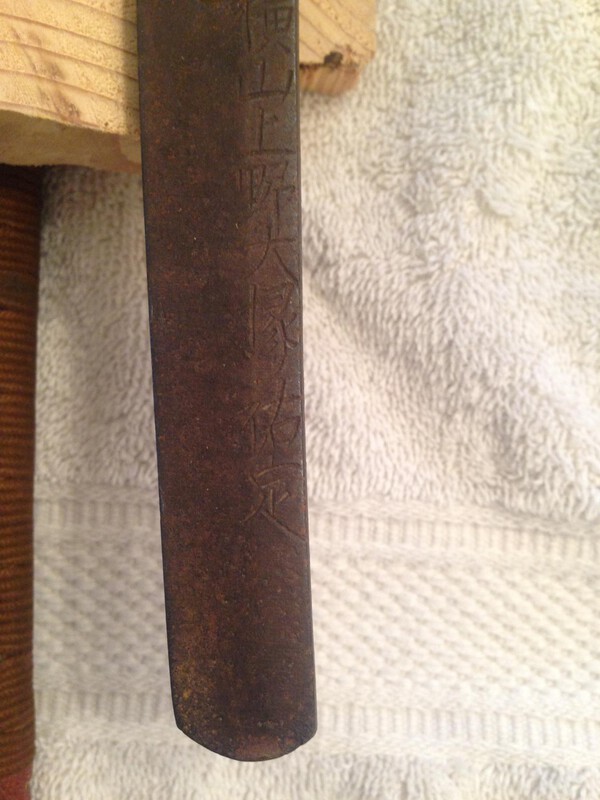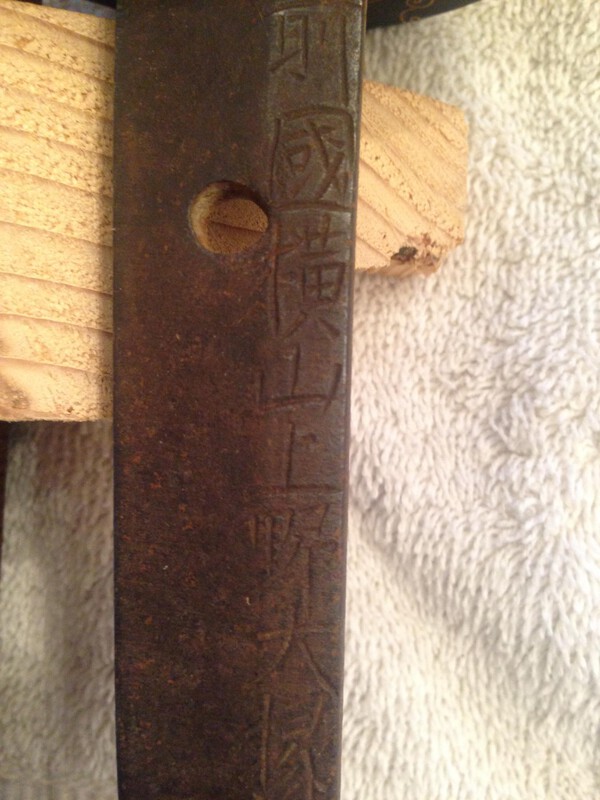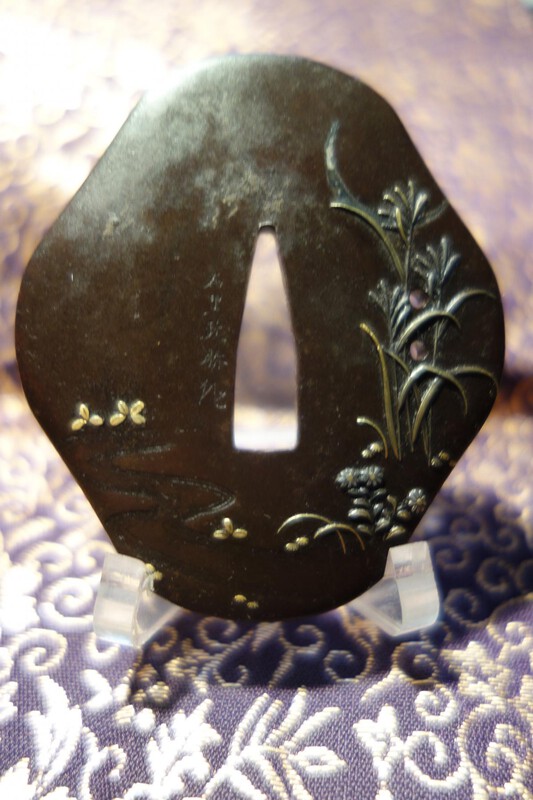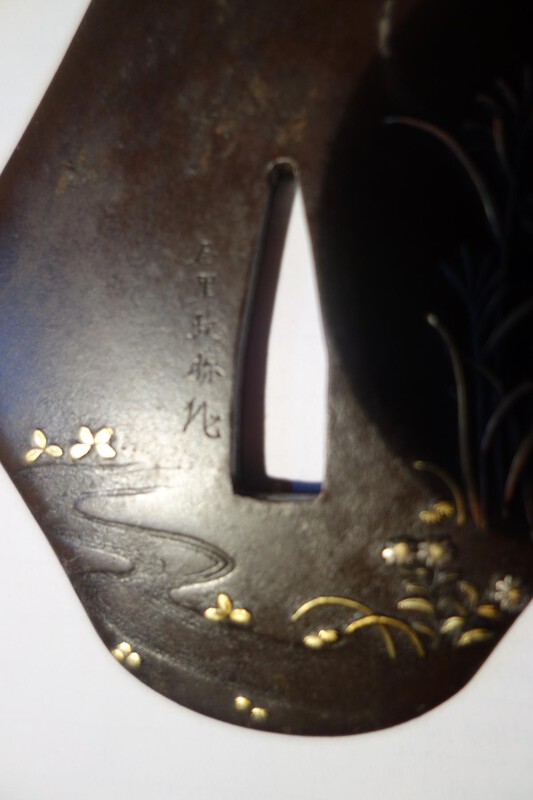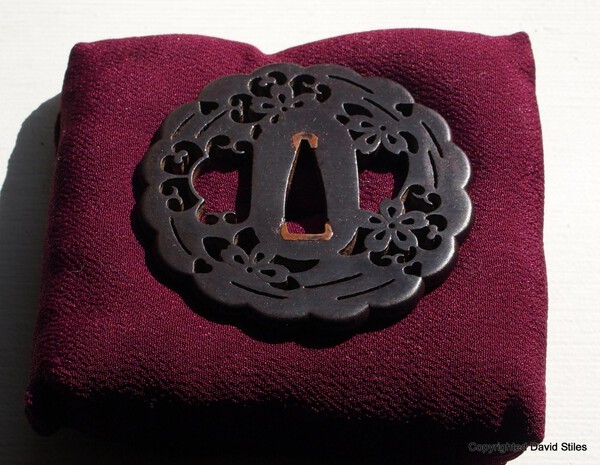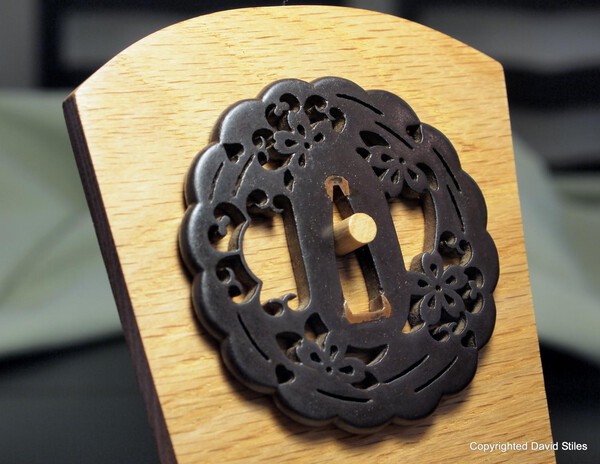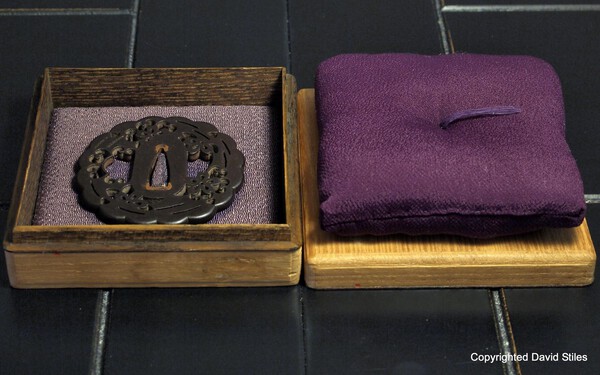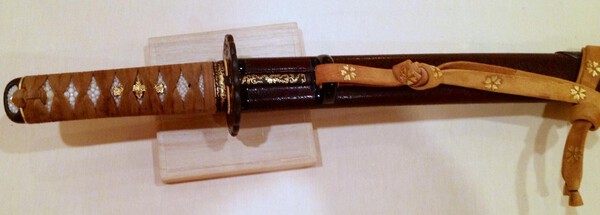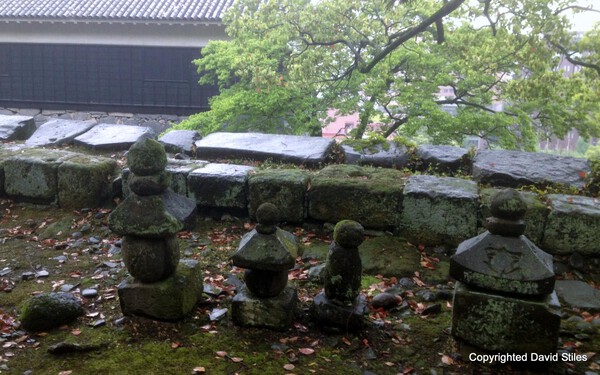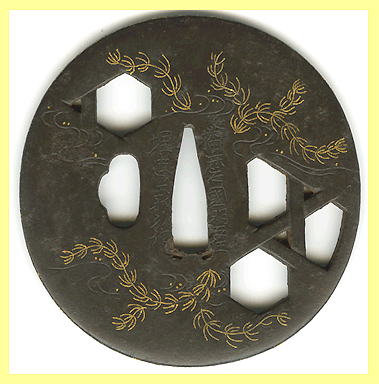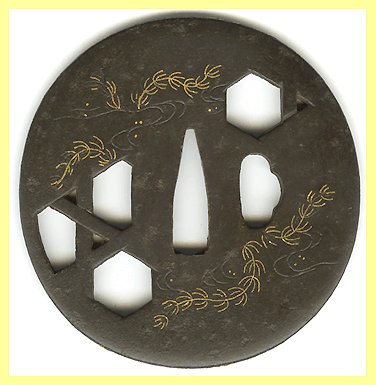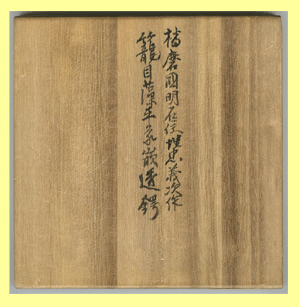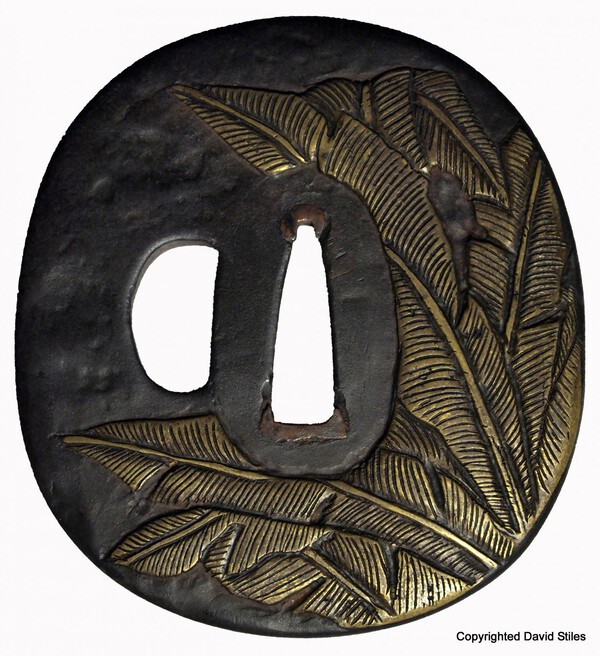Search the Community
Showing results for tags 'tsuba'.
-
Picked up cheap tsuba of ebay and whant your opinion on it. Looks like typical tosho tsuba. But I didn't see tosho tsubas with plugged holes before. Oleg
-
Here is a NBTHK certificate (from eBay auction, small pic) describing a Shōami tsuba: Someone is able to read/guess which is the first kanji before 木瓜形 (mokkō-gata)? Thanks for reading. Mauro
-
Hi all, This iron tsuba of 75 mm wide represents a kingfisher above waterplants plants in suaka and shakudo. Even if on the shakudo leaf i can detect 3 dewdrops (I recently learned thanks to this forum, that they were a kantei mark for Goto school), I don't think this tsuba is from Goto school. But in that case what kind of school it is ? Thank you for you comments and advises Bruno
-
Akemashite Omedetou Gozaimasu (Happy New Year!) Well, it has been quite a while since I last checked in, but I’ve made some inroads in the blade markets here in Japan recently. How would you like to have your own personal buyer in Japan ? I am an antique dealer selling on eBay as araki0726 (check my excellent feedback!) as well as to an ever growing list of direct mail clients all over the world (many of them Nihonto Message Board members). You can also find me on Facebook: Japanese Antique Auctions: https://www.facebook.com/Japanese.antique.auctions. I am not an authority on blades, but I do specialize in Samurai armor, and I can help you find what you need. Much better selection and less competition! I send out offers twice a week. I’m afraid I do not check in here often, so by all means mail me at schmidt_araki@ybb.ne.jp or through my ebay or Facebook pages. Yoroshiku. Kelly Schmidt
-
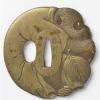
tsuba Hakogaki Translation For An Aizu Shoami Tsuba
Kurikata posted a topic in Translation Assistance
Hello , can someneone help me in translaring the Japanese inscription on my Aizu Shoami tsuba box? Thank you in advance -
Hi, I recently purchased this Tsuba but I am not able to read the signature. As it is a Tanaka Tsuba, I can Imagine that it is Toshi ___ Something (Haru ? Tsune ?) Can someone give me a clue ? Thank you for your help
-
Hello everyone! I was googling today and found these two tsuba attached to two separate auction sites. The one of lesser quality was on Ebay with a starting bid close to $100 if i'm not mistaken (no one fell for it, 0 Bids). I'm wondering if there is any chance that the other could possibly be "real" or are they both just production fakes. Thanks for any opinions! Ken
-
HI, I need some help on this Tsuba Size is 7,8cm - Shape is round - Metal is iron with shakudo and sentoku inclusion. My guess is that it is a nara school tsuba but not vey sure on my opinion. Can you confirm? Topic might be Oshioko back on his ox. But in my case, he is not playing a flute.... Would it be another story? Thank you for your help Bruno
-
SOLD, thank you.
-
Hi (again) I have just received the tsuba and papers as shown below A tsuba by Kishu Sadanaga a pupil of Kawaguchi Hoan. Circa 1700 Motif: Monkey & Kanji Material: Iron, Copper My previous HNB topic link was for a tsuba in the Birmingham museum http://www.militaria.co.za/nmb/topic/12055-monkey-and-kakihane/?hl=kozaru&do=findComment&comment=124779 I have also seen this in a Gallery 3044 (San Francisco) 1982 catalogue Described as: The sosho kanji is well cut with monkey and bamboo cane. The face of the monkey is copper without detail. This style is typical of the Kyoto area in Genroku era ca 1700 (Shoami work). It sold for $300 Morita san replied as below The kao resembles Tokugawa Ieyasu's kao and the monkey means Toyotomi Hideyoshi.??? ----It's just my feeling. :| I've tried the link below in Google translate but nonsense as usual http://www.tokka.biz...ings/TS533.html It fits in well with: 'Toyotomi Hideyoshi had been given the nickname Kozaru, meaning "little monkey", from his lord Oda Nobunaga because his facial features and skinny form resembled that of a monkey. He was also known as the "bald rat" Morita Johns comment That is a really good idea and would have been a grand insult worn by a Toyotomi clan retainer Bob Haynes said this was Choshu dated around 1750 I have translated the papers as Middle Edo and the school as Owari sukashi What I’d really like to know is this papers description to see if there is any reference to Tokugawa Ieyasu's kao Also it looks from the closup that this was black lacquered With thanks Grev UK
-
Hi I bought this tsuba from a NMB member a few weeks ago and I’d like some help with the papers. I’ve blanked out the submitters name as this was normal when on open view This is the information I’ve translated so far Tokubetsu Kichi Nitei-sho certificate Tokubetsu Kichi Nitei-sho in use between 1950 and 1982 and in 1973. A new blue paper was introduced and was a higher level than the previous green paper Tokubetsu Kichi = Especially precious (top rank) - Green paper 1950 to 1972. In 1973 a new blue paper was introduced and was a higher level than the previous green paper Details from the papers Nara school – This is the only mei on the tsuba Cert dated October 25th 1975 A higher grade blue paper was introduced in 1973 as this green paper is after 1973 it would be classed a basic tsuba I would appreciate any help with the ret of the translation or correcting any mistakes I’ve made With thanks Grev UK
-
Hi all. I've had a sword floating around the house for a while and the other day I decided to try and do some research on it. According to a member on another forum (Reddit), it's an antique Japanese tanto from the shinshinto period. I took it apart to take some pictures of the tang, and there were quite a few markings on the tsuba that I was hoping you guys might be able to help decode. There were no markings on the tang, so I'm hoping that the tsuba might be able to tell me a little more about the history of the sword. I know that the fittings were changed pretty often, but this would at least give me a jumping off point. I only have a few pictures of it, but they should be clear enough to read the writing and see the design. I can provide more pictures if needed. Thanks in advance for your help. Since one of my pictures is more than halfway to the file size limit, here's a link to an album I made with a bunch of pictures of the sword. http://imgur.com/a/WzV2m
-
Hi. As many requested from my previouse thread to share my two tsuba bought from Ebay and to identify what they are, I start this thread. So if someone could identify what these are and possibly the ages, it would be appreciated. By the way, these to tsuba came out together within the two $ digits. The sukashi one looks Heianjo kyo sukashi but I am not sure. This one actually was so funny that the seller from Japan took the photo under so dark shade, I didn't even see any of the inlays at the first sight. Besides, the tsuba looked compeletely cast iron tsuba so I guess it has been on the ebay forerver. But I saw very faint shades of inlays + sekigane, I just push the button to buy and requested some close up photos and I got these photos from seller. I hope it's not a fake anything but a hidden treasure at the price. I see zogan works but don't know what is that straight inlays. Seems like the the surface has been messed up by something as if it was stored hundrededs of years inside of fabiric pocket or gauze so. Do you guys have any idea for it if it's authentic? I haven't received the tsuba yet. The other one is truly amazing. It's really heavy and heaviest tsuba among mine. I thought it was tekkotsu but maybe understood wrong. It is legendary purplelish nlack patina that should be seen until early edo tsuba if I am not wrong. This also has a signature that the seller didn't post on his listing. It also seem to have some brass zogan work left on the surface. When I see this on a specific angle? This looks like a jelly iron ( possibly konyaku -like surface) and very well-y smooth on the surface. Two part of the rim are bent as if it was pushed down gently by fingers. I specifically like this a lot and this is the truly quality iron tsuba that you have to touch in hands to know. It's super heavy and forged like iron that doesn't let it rusted too much. For the motiff, I see a stairs and a pine tree and the back ground must be zogan work of bush or leaves. However, It looks like a psychedelic art that at the same time, I remind a face of alien or the monster of the game: Packman or even a skull. So it's a truly amazing. I have never studied this type of tsuba yet so I basically have 0 idea on this tsuba although I like it maybe the most among what I have currently. So anyone has idea of era and school? Thank you very much for the reading. Jason C
-
Major website site update for July 2015. Here is a link detailing all of the major changes to my website: http://shoutout.wix.com/so/5Kv5F-dx. Enjoy and if you have any questions contact me via my website as I don't log on here very often. Thank you.
-
Greetings gents, I've had this question in my mind for a while and thought it would be a good idea to bring it into the forum. When a newbie, or a friend of mine or whoever trys to find information about a subject, Wikipedia is usually the first place they go to. When it comes to tsuba, Wiki only has a small passage in the main article "Japanese sword mountings": https://en.wikipedia.org/wiki/Japanese_sword_mountings#Tsuba Unlinked to the that there are smaller articles on some schools like Umetada and Shoami: https://en.wikipedia.org/wiki/Umetada https://en.wikipedia.org/wiki/Shoami I for one think that the Tsuba deserves a larger, independent article and smaller articles on other schools too. Perhaps short articles about the most famous smiths as well. Given the importance of Wikipedia it might also be a good way to condense information from countless books into a universal format for our enjoyment. Alas, my computer skills when it comes to making webpages or programming are lacking to say the least. So I am simply throwing this idea out there, and if there are plenty of people who agree with me about the need for such an article, perhaps something will happen. What do you think?
-
Here is a link to online newsletter about major updates to my website in June 2015: http://shoutout.wix.com/so/6KsqUYel#/main . Contact me though my website or on Facebook because I don't have time to come here very often. A link directly to me website is also below. Yours truly, David Stiles Tsuba Otaku http://www.tsubaotaku.com
-
Hello Nihonto Members, [Pardon Any Ignorance I May Show... I Am Completely New To Japanese Swords] I recently was lucky enough to acquire what I thought was a basic Japanese Gunto from WW2 (Maybe a Type 98 I thought). The swords scabbard has seen better days and is in rough shape. The swords Tsuka shows signs of use and appears to be typical WW2. The Tsuba looks much older than the sword and is obviously not a typical commissioned guard. The actual blade seems to be in good condition (few spots but no serious issues, chips or dents) as well as it's been sitting in a box in a basement since it was brought back from WW2. After a couple days of having the sword I became more curious as to it's origins since the tsuba looked 100 years older than the rest of the sword. I thought maybe this was an older family blade and tsuba that was re-purposed for the Japanese military. I researched how to ID the sword and came to the conclusion I would have to remove the handle which was nerve wrecking but was really easy to do. My wife laughs at me but I always wear think rubber gloves when holding the sword. Anyways, I took some snapshots of the mei and researched the kanji online. After a bit of research I got lucky and found a similar sword which bare similar kanji which led to me finding more and more and more... examples. Basically I have, I think, a pretty typical but not rare Yokoyamo Sukesada. From what I have researched (and I know basically nothing on these topics) this region, Sukesada, produced a large quantity of swords many years ago. However, all of the similar swords I have seen online have a kanji for a clan (all being "Fujiwara"). My sword has a straight line of kanji with no clan marking. I think it reads "bi zen kuni yoko yama ko zuke dai jo suke sada". I took photos of the one side of tang. I was 95% sure I did not see any markings on the opposite side of the tang so I took no pictures (now I am questioning if there were markings on that side since I am not 100% sure). I also checked the tsuba for any markings but did not see any. Any information anyone might have as to the age or any other details of the blade and tsuba would be much appreciated. I took these photos with an iPhone (Sorry for the quality) but will snap more photos with my dslr if anyone would like more photos. Thanks for Your Time, Chris U.
- 14 replies
-
- translation
- wakizashi
-
(and 1 more)
Tagged with:
-
-
Hi Everyone, Just wanted to start a discussion topic on the art appreciation of Higo tsuba towards the goal of a somewhat better understand. I used the title of the fine JSSUS translation publication by Markus Sesko of the Me no Me magazine article because I find the term "Dandy" defined in Merriam-Webster's Dictionary as "something that is very good or impressive : a very good example of something" very appropriate. I want this topic to be a showcase good examples and interesting discussion of Higo tsuba that Itō Mitsuru and Itō Sanpei would enjoy. To start off this topic I will share three photos of new tsuba to my collection that I was able to acquire at the Tampa show last month. A show in which I was lucky enough to see many fine Higo tsuba and other tosogu at a few different tables including the table I was sharing with Curran. The first photo was taken under bright natural sunlight and nicely displays the deep purplish-black color which is refereed to as (yokan よかん) and is characteristic of tsuba from the Hayashi and Kamiyoshi Schools of Higo Province. One photo shows the tsuba along a complete Higo style koshirae. The positive openwork (ji-sukashi 地透) design is refereed to as (kasumi-sakura 霞桜透) "cherry blossoms in mist". Not sure of the association between cherry blossoms and mist or fog. Interesting the outer rim and therefore the overall shape of the tsuba is that of a chrysanthemum flower. Some more examples of Higo tsuba with this design can be found here: http://blog.goo.ne.jp/tsuba_001/e/4e8cb3aa1475ff8cc12df328afa9d67a. Another very similar example is in Sasano's second English language book (black with the silver dust cover) on page 339. Enjoy, feel free to discuss, and provide any other Higo tsuba you like to add to the discussion.
-
Hi Everyone, This is just a general notice about the major update and changes to my website. Please PM or reply if you have any questions. Here is a short list of updates include links to the specific webpages. Added a NTHK papered Kanayama tsuba to the homepage. Added a complete write up for a large tadpole menuki set to the other Japanese sword fittings webpage. Updated the information on the contact webpage.
-
Hello I know that this Tsuba is from Yoshitsugo of Umetada Family - Harima branch (H 12 238.0) . Can someone help me in translating the signature and also the kanji on the box? Does someone has information on this artist? Thank you for your help.
-
Hi Everyone, Can someone post some examples or references of Tanabe Yasuhira work who studied under Shigenaga the 5th generation Jingo master? I think he was located in Kumamoto during the late Edo Period circa 1850 and worked in a Jingo School style. Attached are photos of a tsuba that might be his work. The design of Banana Palm was made popular by the 5th generation master. This is a large tsuba measuring at 7.8 X 8.5 cm, 4.6 mm at rim. I presented 1:1 scale photos of this tsuba to Bob Haynes in November and received very positive feedback about it from him. I will present this tsuba to Bob in person at the upcoming Tampa Japanese sword show next month. This tsuba will be going to the NBTHK shinsa later this year. More information is available at my website: http://www.tsubaotaku.com/#!gallery4/c1jbk. It is the last tsuba on the webpage. P.S. Here is a example by a Kumamoto artist during the late Edo Period: http://www.tsuruginoya.com/mn1_3/b00027.html ,

